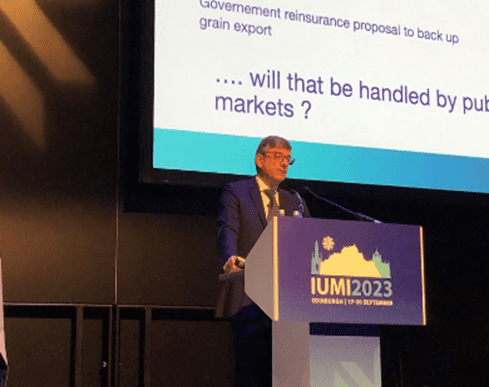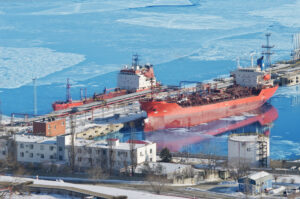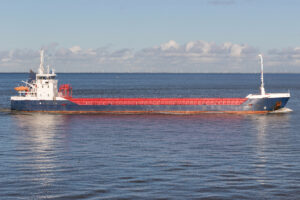The International Union of Marine Insurance (IUMI) presented today its analysis of the latest marine insurance market trends at its annual conference in Edinburgh, Scotland.
Opening the conference, President Frédéric Denèfle expanded and explained the conference common theme by saying that as marine underwriters, they are used to managing an array of casualties and losses onboard a variety of vessels, in ports and other shoreside facilities.
“Dealing with the fall-out from natural catastrophes such as earthquakes and weather events are also workaday issues. Similarly, operating amongst geopolitical chaos is an ongoing problem we face but this has been exacerbated recently with the war in Ukraine,” he said.
Continuing the theme of turbulence, Frédéric Denèfle explained how fragmentation was also causing headaches.
From a trade perspective, covid had highlighted a range of strategic dependencies, it had led to a general reduction in global demand and had encouraged a relocation of activity closer to the consumer.
On the legal side, shipping and insurance was being targeted with increased sanctions as well as local green regulations where, for example, some jurisdictions will not register vessels above a certain age. As the unified spokesperson for marine insurers, IUMI has liaised with various authorities and regulators to support both the industry and underwriters.
A consequence of inflation, caused by covid and the war in Ukraine was already manifesting itself in the increased cost of claims, the requirement to take on more risk as asset values increase, and a related need for more capacity in the market.
Added to this, a general technology shift in terms of clean energy, clean propulsion and autonomous vessels was creating more “turbulence”. However, all new technologies and climate change reduction measures are welcomed by IUMI which stands ready to act as an enabler to their introduction.
Although the marine insurance market was in a state of flux, Frédéric Denèfle was confident in its ability to cope. Furthermore, he stated that he foresses:
· A return to dedicated, experienced teams.
· A heightened reliance on intelligence and data systems to anticipate the consequences of geopolitical uncertainty.
· The emergence of local teams underwriting local business in their own areas to challenge fragmentation.
· An adjustment of market capacities and pricing to fight inflation pressures.
· The creation of specialist teams to fully understand the implications of new technologies.
IUMI: Latest Marine Insurance Market Trends
Offshore Energy
Global premiums in the offshore energy market for 2022 were reported as $4.1 billion, an increase of 7.3% on 2021. There now appears to be an upward trend in the premium base following a prolonged reduction to the bottom of the trough in 2019.
In this market, premiums mirror the oil price which has been relatively strong since late 2020 and more so in 2022. However, oil prices began to fall in 2023 which might herald weaker returns for offshore energy insurers this year and in 2024.
There tends to be a lengthy lag between oil price changes and activation/deactivation of offshore assets. Losses in this sector remain low and relatively stable but the youngest underwriting years will continue to develop and this will be reflected in the loss ratios.
This sector remains in a fragile balance with reduced premiums (but now rising) and a modest claims impact. Risks and claims resulting from unit activation have the potential to disrupt the balance.
Cargo
Cargo insurance returned a global premium base for 2022 of USD20.5 billion, an 8.3% growth on last year. There was growth in all regions especially in Europe and North America although the Asia/Pacific region experienced a slowdown, likely due to the combined effect of economic conditions and major Asian currencies weakening against the US dollar.
That said, the changes in each region’s fortunes might also be connected with where the insurance contract resides, geographically. It should be noted that exchange rate fluctuations tend to impact most heavily on this sector and so direct comparisons with earlier years cannot be exact.
Cargo premiums have demonstrated positive market development over a number of recent years and, in the main, tend to follow the trends in world trade.
Global trade, in terms of value and volume, rebounded strongly post covid and further growth is projected, however forecasts do differ.
Recent underwriting years, including 2022, have returned to a more normal (ie flatter) pattern in terms of loss ratios following a few years of extraordinary upwards claims adjustments. Loss ratios for 2022 are starting at their lowest level since 2015 and, although they will develop, this is positive and may indicate a sustainable improvement for this line of business.
However, cargo underwriters continue to be concerned with a number of persistent challenges such as mis-declared cargoes, vessel fires, accumulation of risk in single locations, climate change, and political tensions. Added to this, a return to pre-pandemic activity, inflation and the growing number of natural catastrophes (nat-cats) are likely to impact on the future claims environment.
Ocean Hull
Global premiums relating to the ocean hull sector increased by 5.7% in 2022 to reach USD8.4 billion. With the exception of Latin America which suffered a sharp downturn, all other regions reported an upturn.
Whilst the distribution of premiums across the regions was relatively static, the Nordic countries enjoyed a marked increase, possibly due to their activity in covering war risks.
2022 saw a continued growth in the world fleet as well as its overall value and this, coupled with reduced market capacity has impacted positively on the premium base.
The gap between total gross tonnage/number of vessels and global premiums – which opened markedly from 2011-2018 – has closed slightly since 2020 and now appears to be relatively stable.
Claims frequency had a long-term downward trend but has shown some increase after the extraordinary dip in 2020, following a return to pre-covid vessel activity. Average repair costs have seen some upward trend probably due to the impact of inflation. Major losses were moderate in recent years with the exception of fires but 2023 has seen an uptick including, again, a number of severe fires.
With the exception of Latin America, loss ratios in all regions are experiencing a downward trend and have done so for the past three years. As with cargo, loss ratios for 2022 are starting from their lowest point since 2015 which is very positive for hull underwriters.
With high value sectors such as containers and cruise ships now fully restored post-covid and the rise in major losses seen, so far in 2023, it remains to be seen how sustainable the current relatively low loss ratio pattern will be.



